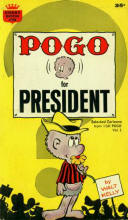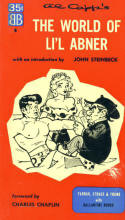|
_small.jpg)
_small.jpg)
_small.jpg)
_small.jpg)
_small.jpg)
_small.jpg)
_small.jpg)
_small.jpg)
_small.jpg)
_small.jpg)
_small.jpg)
_small.jpg)
_small.jpg)
_small.jpg)
_small.jpg)
_small1.jpg)
_small.jpg)
|
|
This might be a BIG oddity to our
younger viewers, but politics in the U.S. was not always so brutally
divisive. Indeed, there was, from time to time, a little middle-ground;
and there was even some room for folks to see a bit of humor, which could
be pointed in either direction.
In 1941, Walt Kelly quit as a staff
animator for Walt Disney, and he was hired at Dell Comics, where he
eventually created his most endearing character, Pogo. Seven years later, he joined
the New York Star and became a political cartoonist, then syndicated
Pogo as a daily comic strip. It became one of the most widely
circulated strips of the time, and ran from 1948 to 1975.

The comics were collected and
reprinted in book format from 1951 through 1978. While several publishers
displayed the work, such as this one by Crest, the vast majority were
printed by Simon & Schuster. In all, there were 45 titles in that
series, a few of which are presented at the left of this page. They were
Trade-sized paperbacks, for the most part, but some were larger. In later
issues, the books were printed under Simon & Schuster's Fireside
label. You can see a complete list of the Pogo Books on Wikipedia.
The strip obviously spent a lot
of time building up the characterization of its numerous
players, then subtly incorporated important topics
 to
the readers, such as greed, love, avarice, jealousy, etc., with ultimately
comical outcomes. Kelly was not the only one to do this, of course. Al
Capp did much the same thing with his Li'L Abner comic strip. In Capp's
case, the microcosm that contained his metaphorical world was the
fictional town of "Dogpatch." Kelly's setting was the Okefenokee Swamp in
South Georgia, and all of his characters were animals. Still, many of them
(especially some that were "just passing through") bore an uncanny
resemblance to political figures of the day, and some of the social problems that
came to the swamp were obviously taken from headlines. to
the readers, such as greed, love, avarice, jealousy, etc., with ultimately
comical outcomes. Kelly was not the only one to do this, of course. Al
Capp did much the same thing with his Li'L Abner comic strip. In Capp's
case, the microcosm that contained his metaphorical world was the
fictional town of "Dogpatch." Kelly's setting was the Okefenokee Swamp in
South Georgia, and all of his characters were animals. Still, many of them
(especially some that were "just passing through") bore an uncanny
resemblance to political figures of the day, and some of the social problems that
came to the swamp were obviously taken from headlines.
|